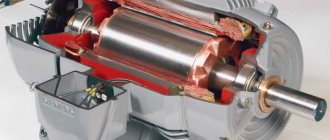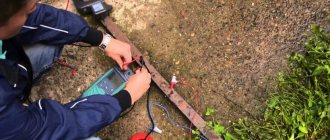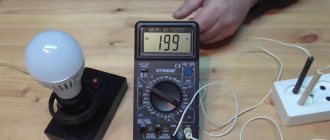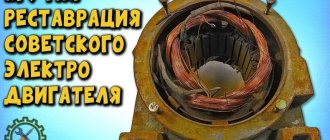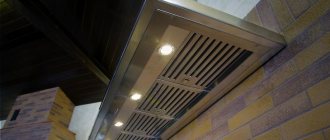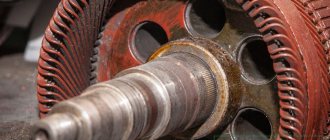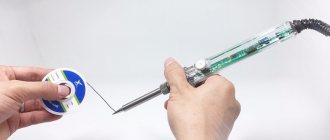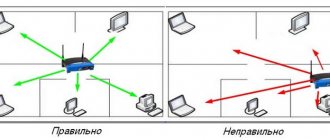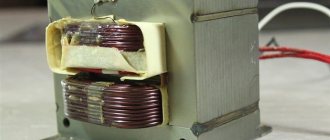In a previous article, I talked about how to check, find and troubleshoot brushed electric motors, which differ in that they have a brush-commutator assembly. Now I will tell you how to check, find faults and repair an asynchronous electric motor, which is the most reliable and easiest to manufacture of all types of motors. They are less common in everyday life (in a refrigerator compressor or in a washing machine), but they are often found in a garage or workshop: in machine tools, compressors, etc.
Repairing or testing an asynchronous electric motor with your own hands will not be difficult for most people. The most common failure of asynchronous motors is wear of the bearings, and less often, breakage or dampness of the windings.
Most faults can be identified by external inspection.
I recommend periodically , in order to extend the service life, check the condition of the electric motors: the condition of the bearings, clean the inside of it from debris and dust, and especially the ventilation holes.
Before connecting or if the motor has not been used for a long time, it is necessary to check its insulation resistance with a megger. Or if you don’t know an electrician with a megger, then it wouldn’t hurt to disassemble it for preventive purposes and dry the stator windings for several days.
Before starting to repair the electric motor, it is necessary to check the presence of voltage and the serviceability of magnetic starters, thermal relays, connection cables and a capacitor, if present in the circuit.
Disassembling a typical asynchronous motor
Since there is a wide variety of designs of electric motors, to disassemble a particular electric motor you need to study its drawings and repair instructions, and watch visual videos.
But in general terms, the designs of electric motors popular in everyday life are similar - there are rolling bearings on the rotor shaft, the outer races of which are pressed into seats on the inner surfaces of the end shields (covers).
Design of an asynchronous three-phase motor with a squirrel-cage rotor
The shields themselves are centered using a machined cylindrical edge that matches in size with the groove on the stator casing. The end shields are fixed using bolted connections. When disassembling the engine, its shaft is disconnected from the driven mechanisms and the electric motor is removed from the frame.
Removing the engine from the workplace
After this, it is necessary to remove the mechanical energy transmission element (pulley, gear, flange, etc.) from the shaft.
After unscrewing the fastening bolts, use a puller to remove the end shields from the bearings, after which you can carefully remove the rotor
Bearing puller
The bearings are cleaned, re-lubricated or replaced, the rotor and stator surfaces are cleaned, and the engine is reassembled. There are many bearing removal methods, methods and tools.
Classification of electric motors
When checking an electric motor for serviceability, it should be borne in mind that not all types of motors can be checked in this way. There are a wide variety of electric motor designs; most problems can be diagnosed using a multimeter. However, it is not necessary to be an expert in this field.
Modern electric motors can be divided into several groups:
- Asynchronous three-phase with squirrel-cage rotor. This model is very popular because the device is simple and can be diagnosed using a conventional measuring tool.
- Asynchronous capacitor, short-circuited with one or two phases. This version of the design is installed in household appliances; the device can be powered from a regular 220 V network. Today, such an electric motor is also widespread and is found in almost every home. In this case, checking for malfunction is carried out using a standard tester. The single-phase model is economical and practical to use.
- Asynchronous, equipped with a wound rotor. This motor is checked quite often, which is due to the more powerful starting torque. This model is installed on various production equipment and various large equipment. An example would be cranes, lifts or various machines.
- Collector, which are powered by direct current. An inspection of such a device is carried out quite often; it is used in various cars for fans and pumps, wipers. Such an electric motor can burn out for various reasons; timely inspection allows you to identify the problem.
- Collector with alternating current. Electric hand tools have become very widespread. To transmit rotation, a commutator motor is installed, which can be checked using a megohmmeter.
Before checking the electric motor with a multimeter, a visual inspection is carried out. Even with the naked eye you can identify a burnt winding or serious mechanical damage. However, if the structure visually has no defects, then a special measuring tool should be used.
Checking bearings and insulation
Bearing wear in an asynchronous motor is, in essence, the only parts that need to be replaced regularly. In powerful engines, the bearings are subject to large loads, leading to backlash and beating, which can be heard as quite loud noise when the rotor rotates. The rolling surfaces lose their original shape, and the cage begins to crack.
If the cage breaks during rotation, the rotor will no longer be coaxial with the stator and will snag on it. The consequences of such an accident will be very destructive for the engine and will most likely lead to its complete disrepair and impossibility of restoration. The condition of the bearings is determined by a special device based on noise level.
A very important and mandatory parameter to check is the state of the insulation of the wires and stator windings of the engine. To do this, you will need a special device - a megohmmeter.
Determination of the technical condition of the short-circuited rotor winding
- Connect one of the terminals of the phase winding, from the intercoil connection of which an additional terminal is made, and an additional terminal to the circuit to determine breaks in the rods of the short-circuited rotor windings.
- Apply an alternating current voltage of 10-15 V to the phase coil from the circuit.
- Slowly rotating the rotor until it makes one or one and a half turns, monitor the readings of the ammeter connected to the circuit of the phase winding coil, the terminals of which are energized. When the current changes, record its maximum and minimum values in a log. The constancy of the ammeter readings when turning the electric motor rotor indicates the absence of breaks in the short-circuited rotor winding rods. A change in current indicates the presence of a weakening of the cross-section or breakage of the rods.
Calculate the relative change in current using the formulaIf the relative change in current exceeds 15%, then the electric motor is disassembled and the number of broken rods is determined.
Note: If the electric motor is not adapted for diagnostics, then voltage is supplied to the phase winding. In this case, the permissible relative change in current when turning the rotor is 10%.
- Disconnect the motor winding from the circuit.
How to check the winding of an electric motor?
The next stage of testing is to check the motor winding for a short circuit to its housing. Most often, a household motor will not work with a closed winding, because the fuse will blow or the protection system will trip. The latter is typical for ungrounded devices designed for a voltage of 380 volts.
An ohmmeter is used to check resistance. You can use it to check the motor winding in this way:
- set the ohmmeter to resistance measurement mode;
- we connect the probes to the required sockets (usually to the common “Ohm” socket);
- select the scale with the highest multiplier (for example, R*1000, etc.);
- set the arrow to zero, and the probes should touch each other;
- we find a screw for grounding the electric motor (most often it has a hex head and is painted green). Instead of a screw, any metal part of the case can be used, on which the paint can be scraped off for better contact with the metal;
- We press the ohmmeter probe to this place, and press the second probe in turn to each electrical contact of the engine;
- Ideally, the meter needle should deviate slightly from the highest resistance reading.
While working, make sure that your hands do not touch the probes, otherwise the readings will be incorrect. The resistance value should be shown in millions of ohms or megohms. If you have a digital ohmmeter, some of them do not have the ability to set the device to zero; for such ohmmeters, the zeroing step should be skipped.
Also, when checking the windings, make sure that they are not short-circuited or broken. Some simple single-phase or three-phase electric motors are tested by switching the ohmmeter to the lowest range, then setting the needle to zero and measuring the resistance between the wires.
To make sure that each of the windings is measured, you need to refer to the motor diagram.
If the ohmmeter shows a very low resistance value, it means that it either exists, or you touched the probes of the device. And if the value is too high, then this indicates problems with the motor windings. for example, about a breakup. If the resistance of the windings is high, the entire motor will not work, or its speed controller will fail. The latter most often concerns three-phase motors.
How to check an asynchronous motor
The standard three-phase stator is equipped with three windings. Six wires come out of the stationary mechanism. Some types of structural designs are equipped with 3 or 4 terminals - found when making connections of the “triangle” and star type, arranged inside the housing. This solution is used extremely rarely due to the more complex maintenance of power units.
Diagnostics of a power machine consists of several stages. Complexity is the main feature of engine testing. It also allows you to test the unit from all sides. Performance testing activities include:
- preparation is notable for its preliminary de-energization. This is an elementary action, but some repairmen forget to disconnect the unit from the power supply network, which can cause the measuring device to fail;
- calibration - before ringing, the multimeter must be adjusted. To do this, you need to set the arrow to the zero position, i.e. the probes short out;
- visual diagnostics to detect visible damage without directly disassembling the power machine.
Asynchronous, commutator motors are called according to the same basic principle. The differences between the methods lie in the design features of the machines. A multimeter operating in ohmmeter mode can determine the identity of the windings - one probe is placed on an arbitrary output, the second one measures the resistance at the remaining outputs. Further, when a pair of wires is detected, marking is used - it is arbitrary, necessary in order not to get confused in the dialing process.
Winding is created by one wire. It has the same number of turns, forming equal inductive reactance - you should rely on this, since when the wire is shorted or broken, the active resistance (and total) will “jump”. The differences are determined by a measuring device. Jumps can be a consequence of an interturn short circuit.
Important : Measurements of active resistance (AO) of stator windings with further comparison is a way to accurately determine the integrity of the circuits of a stationary mechanism. That is why preliminary diagnostics are carried out before repairs are carried out.
A feature of single-phase asynchronous motors, regarding stator windings, is the fact that power machines are classified with two types of windings: working, starting, for example, in a washing machine.
Diagnostics will show:
- with a smaller value – working rewinding of the stator;
- average resistance – starting winding;
- increased resistance parameter - two windings connected in series.
The AO parameter in the first is always smaller - this aspect is also worth taking into account. If three ends are removed from a stationary mechanism, then you need to measure the AO at all. The result obtained after three measurements is taken into account.
Checking consumables - bearings
Visual examination (described above) is the first stage of a comprehensive diagnosis. It is necessary to inspect in detail not only the surface of the motor - it may be completely serviceable, but at the same time differences in performance are observed.
Together with the engine, bearings are checked to ensure smooth and free running of the moving mechanism in the stator. Placement at both ends of the rotor in special niches. Some bearings are automatically lubricated by fittings, while others require a lubricant.
How to check consumables:
- the engine is placed on a hard surface;
- you need to put your hand and the other to turn the rotor;
- if the VE is faulty, then characteristic scratching sounds, increased friction, and uneven movement occur. The entire EV will move without problems;
- The longitudinal play of the VE is inspected in detail - it is pushed by the axis located in the stator. The permissible value is no more than 3 millimeters inclusive.
Problems with the above parts cause noisy operation. Worn out or completely faulty consumables overheat significantly, which leads to serious damage to the power equipment as a whole. It is extremely important to carry out full maintenance on time - this will prevent the risk of breakdowns of varying complexity.
Start and end of stator winding
The technique will allow you to determine the direction of rewinding the wire. The fixed motor mechanism has a lot in common with the transformer, and therefore it is considered as the latter. Processes similar to those of a transformer occur in the stator, which allows for comprehensive diagnostics.
To carry out the test, the following instruments are required:
- voltmeter with increased sensitivity to changes in parameters;
- a source that generates constant voltage - a standard battery will do.
A pointer voltmeter is preferable as it shows the variation of parameters more clearly. Digital is also suitable, but it is more difficult to track the trend of changes in characteristics.
A voltmeter is connected to one winding (you choose the type), and a voltage source is connected to the other, the latter is immediately removed. Attention should be paid to how much the needle of the measuring device has deviated:
- when exposed to the “plus” of the first winding, an electromagnetic pulse with a deviation to the right appeared in the second, and if you turn it off, a movement to the left is observed, then both wires are in the same direction;
- with the opposite effect, the measuring device or battery switches. Similar actions are performed with the third winding.
The battery power is not always enough. Because of this, measurement accuracy is not always ensured. Therefore, when diagnosing operability, use high voltage sources. Professional megaohmmeters are perfect here.
Home measurements
There is a “life hack” that allows you to take control measurements without using megohmmeters. The terminals of the stator winding are supplied with household voltage from a 220 volt network through a special incandescent test lamp. The power of the latter does not exceed 75 watts. Another measuring device is also used - an ammeter connected in series.
Important : This method is highly not recommended due to the increased danger. Measurements are taken with the electrical network turned on, which can cause irreparable harm to health. This method is used by professional electricians who have a third or higher safety group.
The leakage current should not exceed microamps, taking into account emergency mode. Therefore, measurements begin at ampere limits. Having determined the current with an ammeter and the voltage, the winding insulation resistance is calculated.
The technology involves supplying a full phase to the motor housing. The latter must be placed on a dielectric base without direct or indirect contact with other objects on the working plane. Due attention is paid to safety when making measurements - ultra-reliable insulation of the ends of the winding and wires is necessary before checking the functionality in this way, it is necessary to check the quality of fastening of the clamps. Keep the lamp bulb in a protective case to prevent it from breaking.
Measurement of AO and resistance between winding insulation
When measuring active resistance, you need to completely disassemble the wiring diagram, including removing the jumpers. Switch the multimeter to ohmmeter operating mode and determine the AO of each of the presented stator windings. If the device shows the same values, then everything is fine. But sometimes there are small deviations due to the measurement error of the device used.
An ohmmeter will not work when measuring insulation resistance. It must be switched to a megohmmeter. A standard multimeter is often misleading, showing that the insulation is working properly, but in fact there will be damage. Therefore, its use is not recommended.
Tip : Immediately before starting the checks, you need to study the connection diagram. Some connections are made by connecting a central point to the motor housing. If the rewind has several points, then diagnostics of the insulation condition is carried out both between any connection point and directly between the housing.
Sometimes there is very little resistance. The test involves disconnecting the winding and testing the performance of each winding separately. The nominal resistance between the coils and the housing is not lower than 20 MΩ. But there are units that have a parameter lower than that specified due to the fact that they were operated in difficult conditions, for example, in damp rooms. The drive is completely disassembled, the internal parts are thoroughly dried with an incandescent lamp. Resistance is measured with a multimeter with a measurement limit tailored to the maximum resistance.
To test motors designed for a nominal power supply of 220 and 380 volts, specialized measuring devices are used that generate test voltages in the range from 500 to 1000 volts.
Tip : Before checking, read the passport documentation from the manufacturer. It indicates all the necessary information: the maximum permissible test voltage parameter, base power, type of connection of the stator windings.
Diagnostics of low-power electric motors rated 12 volts and 24 volts use a conventional tester. The use of more powerful equipment is strictly prohibited, since the insulation of such power units is unable to withstand large amounts of voltage.
Checking the rotor of electric motors
The rotating element, and in particular its windings, create a magnetic field. It is influenced by the field of a stationary mechanism. The armature windings must be fully operational, otherwise the energy that the magnetic field has will be wasted.
The difficulty of taking measurements arises due to ignorance of the structural designs of the rotors. They all have the same principle of operation, but the different designs cause a number of problems when testing their functionality.
Electric motors with phase wind turbine
Metal rings are placed directly on the moving part of the motor, protruding as wire leads. They are located on one side of the shaft near the rolling bearings.
The circuit wires are assembled to the rings - this can cause some difficulties. No need to turn it off. But the measuring principle used for the stator also applies to the rotor. The latter is taken as a transformer, and the resistance of the circuits and the quality of the insulating layer of both designs are compared.
Asynchronous motors with rotor
Taking measurements is much easier than in previous cases. But there are still some nuances. The rotors of asynchronous machines are made in the form of a “squirrel wheel”, which ensures the highest reliability of the design. Short-circuited windings are made using thick rods of aluminum or copper. They are pressed into bushings. The design withstands the flow of currents arising from a short circuit.
But even the above-mentioned design, sooner or later, fails. This happens due to improper maintenance or when the service life comes to an end. Breakdowns occur less frequently. It is not advisable to use a regular digital multimeter here - the measuring device will not give the desired result.
Other technical equipment will be required that can organize the supply of voltage to short circuit such a rotor while simultaneously controlling the resulting magnetic flux. Failures of the internal structure are accompanied by the formation of cracks. They appear on the rotor housing - a detailed inspection will reveal them.
Testing performance under the created load
Drawing conclusions about the condition of an electric motor based solely on the indicators of measuring devices is a rather rash decision. To get the correct result, you need to diagnose the power unit under load. This approach to research will clearly show how the motor consumes its own power during nominal operation.
It is necessary to carry out diagnostics under load after measurements of the basic indicators and measurements of the temperature range during operation. Minor problems undetected in time will lead to more serious malfunctions, to eliminate which it is necessary to resort to expensive repair work.
Basic malfunctions of three-phase asynchronous electric motors and ways to eliminate them
Basic malfunctions of three-phase asynchronous electric motors and ways to eliminate them
Malfunctions of windings of asynchronous electric motors and ways to eliminate them
Short to body. If the winding is short-circuited to the housing, you need to check the electric motor with a test lamp powered from the mains (Fig. 31).
In some cases, it is advisable to open the winding at several points and check it in parts. First tested
each phase separately (Fig. 32), and then the pole-phase winding groups (Fig. 33).
Short circuit of turns. In this case, several turns or the coil as a whole are closed. The first way to find damage: determine overheating of the frontal parts of the winding by touch. The second method: the winding is fed with alternating current of high frequency (up to 400 Hz) and a piece of steel is applied to the stator core along the entire circumference. The place of damage is under the pole, where the steel is weakly attracted.
A short circuit of the pole-phase group is usually determined using a compass moved around the circumference of the stator
If the windings are connected by a star, then the positive pole of the current source is connected to the terminals in turn, and the negative pole is connected to the zero point of the winding.
The same method can also detect the inverted phase of the winding.
When connecting the winding with a triangle, you need to open one of the vertices of the triangle, to which direct current is supplied.
A short circuit of most of the phase winding is determined by measuring the undervoltage current or the phase resistance of the windings (Fig. 35). An increased current in one of the phases and a decreased resistance indicate the presence of a short circuit (Fig. 36).
Flail break. Typical and common breaks occur when the connection of the winding conductors is broken. If the winding is connected in a star and does not have parallel branches, then a winding phase failure is easily detected by a test lamp connected according to the diagram in Figure 37.
If the winding is connected in a triangle (without parallel branches), then it is opened and each phase is checked separately with a test lamp.
For electric motors with parallel winding branches, the damaged phase is determined by measuring currents in individual phases. Subsequently, the damaged phase is divided into parallel branches, which are studied separately.
Technical data of DC electric motors type MP
To leave a comment, please register or log in to the site.
Integrity of insulation and connection
If the insulation of the electric motor windings is damaged, overheating, a drop in torque on the shaft, an increase in leakage current to the ground or dangerous voltage on the drive housing may occur.
Leakage current may occur in one of the windings, and its value may be small compared to the rated current of the motor. In this case, the thermal protection will not work. To diagnose this malfunction, it is recommended to install a residual current device (RCD), which will respond to leakage current exceeding the rated differential current of the RCD.
Grounding diagnostics must be done visually. It is also necessary to periodically measure the grounding resistance. We will look at diagnosing engine overheating below.
Types of electrical machine repairs
To prevent malfunctions, maintenance and scheduled repairs of electrical equipment should be carried out according to the approved schedule.
Electrical machine repairs are divided into maintenance (MOT), current, medium and major repairs. The scope of work in each of these types of work is determined by the “Standard Regulations on Maintenance and Repair (MRO) of Electrical Equipment”.
Maintenance
This is to maintain equipment in working order between scheduled repairs. Carried out by maintenance and operational maintenance personnel.
Provides for the following types of work:
- inspection;
- heating check;
- wiping off dirt;
- insulation check;
- identifying faults and eliminating them.
It is carried out according to the approved schedule and during downtime - lunch break, adjustment, tool change.
Maintenance
Maintained in working condition until repaired. Produced on site or in a workshop. Includes:
- complex of maintenance works;
- replacement of failed components - bearings and couplings;
- adjustment and checking of alignment.
Medium renovation
For problems that cannot be eliminated during routine repairs, a medium repair is performed. This produces:
- complete disassembly;
- if necessary, replace bearings;
- repair of housing and shaft;
- impregnation of windings with varnish;
- insulation or replacement of leads
Medium repairs are carried out in specialized workshops and enterprises.
Major renovation
Complete restoration of characteristics and parameters. In addition to the complex of medium repair works, the windings of the electric machine are replaced or repaired.
Electric motor malfunctions are easier to prevent than to eliminate their consequences. To do this, it is necessary to carry out a set of work on servicing the mechanism in a timely manner and equip it with the necessary protective devices.
{SOURCE}
Reasons for failure of electric motors
All faults can be divided into two groups - failure as a result of improper transportation or storage and breakdowns that appeared during operation.
Improper transportation and storage
The main problem that appears during this period is increased humidity, and even more so when the electric machine gets caught in the rain. This leads to a breakdown of the insulation, and in more severe cases, to the appearance of rust inside the device and bearings.
Therefore, before installing such a device, it is necessary to carry out routine repairs and eliminate the detected problems:
- carry out an external inspection of the machine, insulation on the terminals and internal jumpers;
- check the insulation condition with a megger;
- check the presence of lubrication and the condition of the bearings;
- in commutator motors of direct and alternating current, as well as in asynchronous machines with a wound rotor, the condition of the commutator or slip rings and brushes is determined.
All these operations are carried out in a warehouse or workshop near the site of future installation. If it is impossible to eliminate the problems, the electric machine is sent to a specialized enterprise for medium repairs.
Reasons for failure during operation
During operation, the main reasons for failure of an electric machine are:
- Mechanical wear of bearings. This occurs throughout the entire service life, as well as due to increased vibration and irregular lubricant changes. To prevent such situations, it is necessary to carry out full maintenance of all components and mechanisms. Failure to correct the malfunction in a timely manner leads to increased engine vibration, overheating of the bearing shields, wear of the bearing seats and jamming of the rotor.
- Destruction of the housing, bolts and bearing seats. Occurs due to increased vibration of the gearbox and poor alignment of the electric motor. The electric drive must be removed or replaced immediately. The consequences are similar to bearing failure.
- Motor overload and operation of three-phase devices in two phases. Correctly configured thermal relays protect against this. If there is no protection, the device will overheat above the maximum permissible temperature, which will lead to failure of the electric machine.
Reference! New electric motors are equipped with a temperature sensor that turns off the mechanism when the device overheats. It can also be additionally installed in the engine of an older model.
Design of a typical three-phase electric motor
Power units, namely engines, have a unified design. It can be modified to expand functionality, but the basic design is retained. The asynchronous motor is equipped with the following mechanisms that ensure comprehensive operation:
- a fixed element - the stator;
Consists of a core, winding, frame. The core is part of the magnetic circuit of a power machine, notable for its hollow cylinder shape. The grooves are located on the inside, spaced evenly. It is produced by using pressed sheets of electrical steel, which are stamped with rings with projections and depressions.
On both sides the sheets are covered with a specialized insulating film. This significantly reduces the formation of eddy currents. The latter, as a rule, are formed in the core during operation of the electric machine. A three-phase winding made using copper or aluminum wire is placed directly in the grooves. The ends of the wiring are connected with clamps.
- rotating component - rotor;
Some motors use an armature - we are talking about installations that have a brush-commutator unit (BCU). This component also consists of a core, includes windings and a shaft. The cores of both elements are separated by an air gap, which prevents contact between each other.
Power units with a squirrel-cage rotor are distinguished by windings inserted into slots. They are made from bare copper or aluminum rods. The ends of the latter are connected by short-circuited rings (made from the same material as the rods).
Interesting : This type of winding is often called a squirrel cage.” For machines whose power reaches up to 100 kilowatts inclusive, the rotor winding is manufactured using the technology of filling the grooves with aluminum under pressure. Rods, short-circuiting rings, ventilation blades are cast immediately. The places where the winding is placed are formed closed, round or oval.
The operating principle is based on the effect of a magnetic mole (MF) of a stationary component on a movable one. This effect is created by the formation of an electromagnetic field, which is a consequence of the flow of electric currents in the stator windings. Evidence of the serviceability of the latter is the flow of exclusively rated currents. When the condition of the stator windings is disturbed, leakage currents are formed, a short circuit is created, and other damage appears. All this is a consequence of the deterioration of the insulation condition.
There is a gap between the stator and the rotor that prevents contact between the moving and stationary parts of the electric motor (the size is determined directly by the manufacturer, and often depends on the size of the electric motor).
Inside the power plant there are consumables - elements that ensure normal operation of the units. Their malfunction, represented by wear, leads to a violation of the gap that is located between the stator and the rotors. The problems with the operation of power units are aggravated by:
- broken bearings;
- abrasive particles, often the products of the interaction of service fluids, the occurrence of physical processes, and trapped inside the mechanisms. When in contact with the elements, they create an additional impact that disrupts the operation of the units;
- improper disassembly and subsequent reassembly using improvised means instead of professional tools.
If there is contact between moving parts and stationary parts, then a mechanical load is formed, which ultimately leads to breakdown of the electric motor. These aspects require high-quality and comprehensive testing; it is also important to test the working winding and test the entire electric motor with a multimeter.
Important : Unskilled disassembly using “makeshift” equipment is often the main cause of breakdown of electric drives. When dismantling, disassembling and subsequent reassembly, it is necessary to use only special equipment, pullers, that prevent damage to the faces of the shafts.
conclusions
Today, there are already many methods for diagnosing the condition of an asynchronous motor during its operation. All of them are still being improved, which confirms their relevance and practical performance.
In this work, the most well-known of them were considered, and it was highlighted that the most promising methods for practical implementation are methods for diagnosing an asynchronous motor, based on the analysis of the electrical parameters of the motor, namely the spectra of voltages and currents. There is also a requirement for the sampling frequency of measuring channels for this method.
Further research is aimed at the following aspects:
- Selection of the optimal structure of the circuit for the practical implementation of the diagnostic method for an asynchronous motor;
- Calculation and selection of necessary equipment;
- Presentation of a working diagram for the practical implementation of diagnostics of an asynchronous motor during its operation.
At the time of writing this essay, the master's thesis has not yet been completed. Estimated completion date for the master's thesis: June 2022. Full text of the work and
